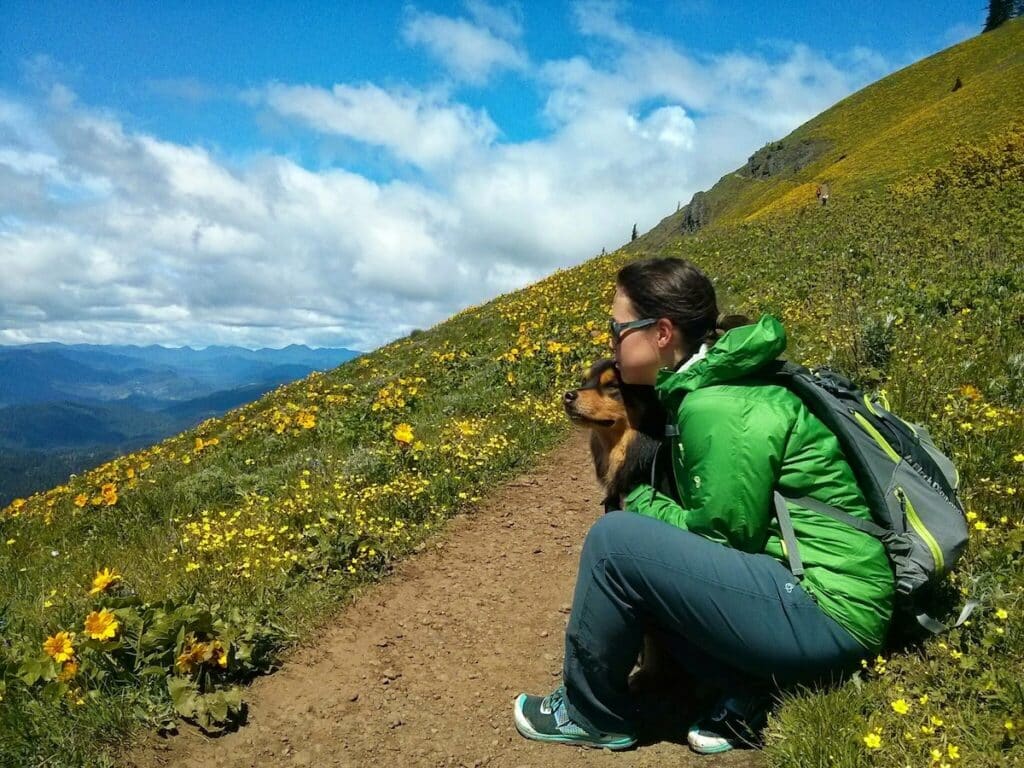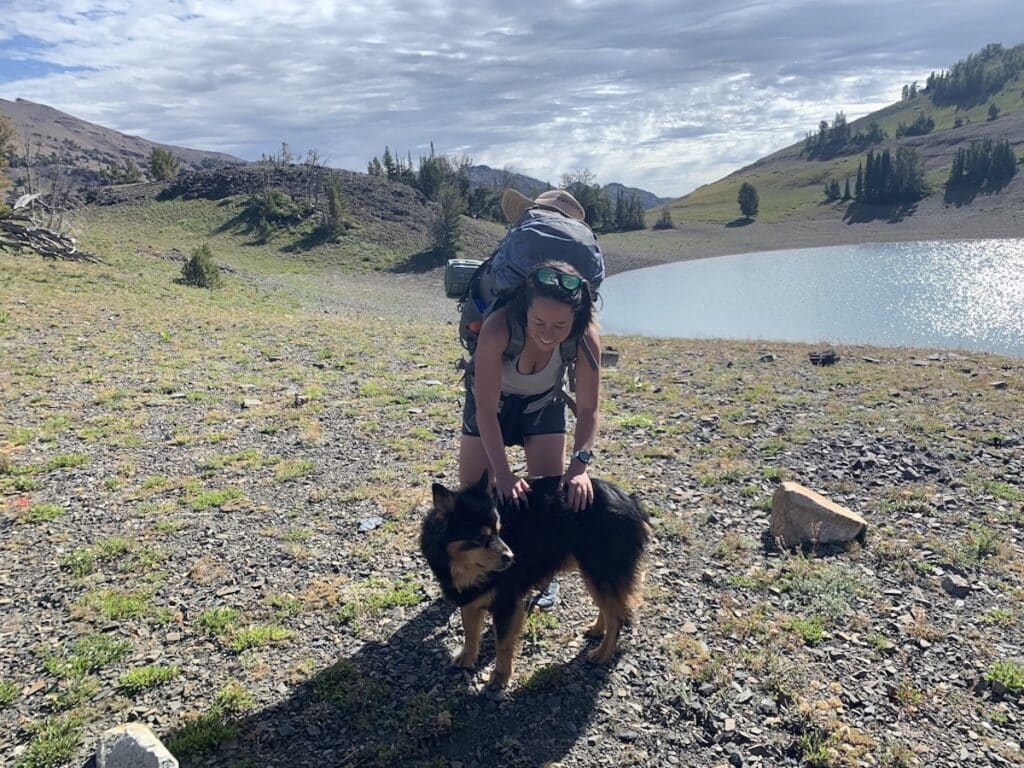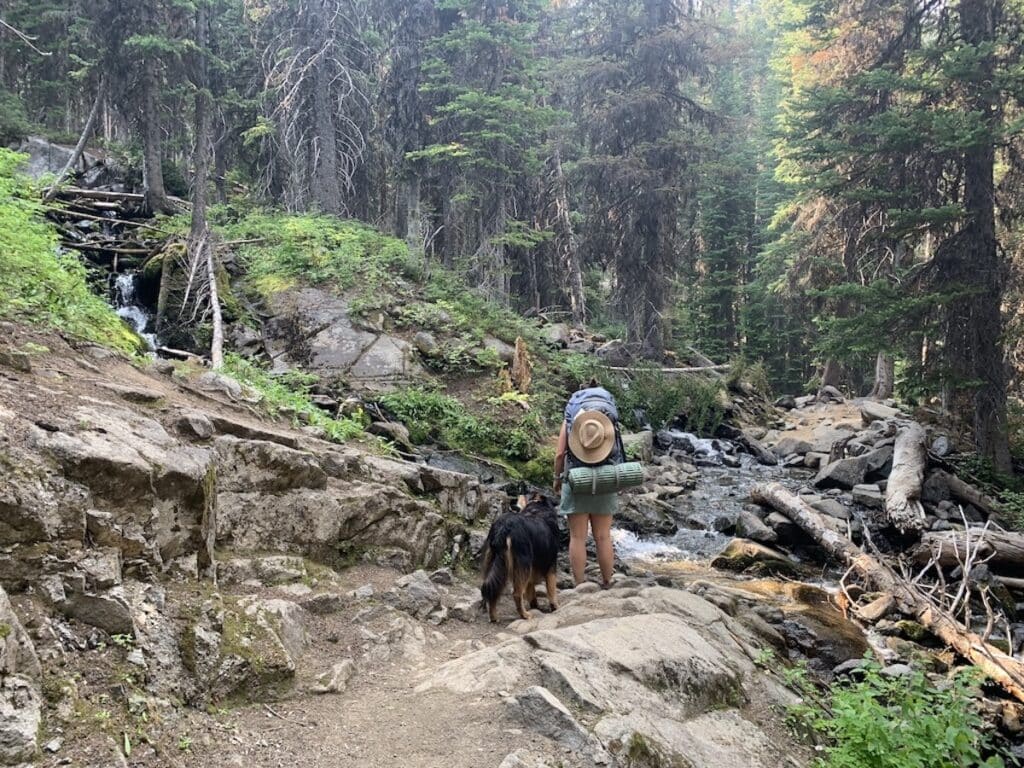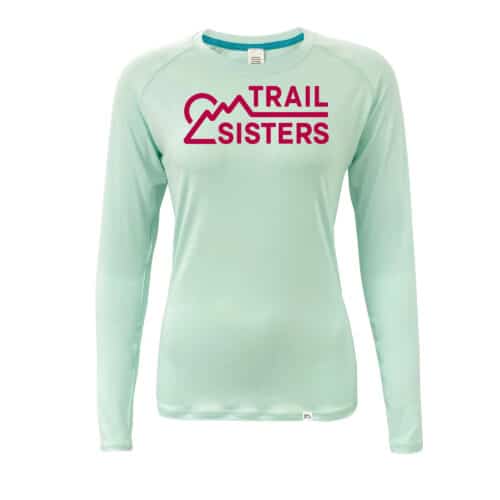Main Menu
Trail Partner

Sarah Carter is a doctor, aspiring writer, and avid lover of her rescue pups and the outdoors. Mountaineering has taken her to South America, Alaska, and the North Cascades. She also loves trail running and backpacking in her free time. In addition to wilderness adventures, Sarah enjoys baking bread, reading, and watercolor painting.
Share This Article!


By: Sarah Carter
I ascend upward through the forest, dappled morning sun hitting the trail through a shady canopy of evergreens, moving at a pace somewhere between a brisk hike and the slowest run. Up, up, up I go until I am above the treeline, legs and lungs on fire, surrounded by sweeping views of the North Cascades. A hairpin turn leads me down briefly to a moraine still covered by a sheet of snow with a crystal clear creek running out from under it. My breathing slows, and I feel a twinge in my chest. Milo would love this spot. I imagine him lying in the creek lapping up the ice-cold water. I close my eyes, and I hear his soft panting and the jingle of the metal tags affixed to his collar as he canters behind me.
For the last two summers, I have been alone on the trails, without my steadfast adventure dog by my side. In the winter of 2021, at 11 years old, arthritis began slowing him down gradually but steadily to the point where he could no longer safely venture into the wilderness with me after the mountain snows melted away the following spring. As Milo gets older, I am continually adjusting what our quality time together looks like – long and ambling neighborhood walks, trips to the beach, short hikes in the local forests, visits to neighborhood parks, car camping trips – and I deeply appreciate these moments, but I am also keenly aware that these microadventures are not the same as the hundreds of days and thousands of trail miles we have logged together.
I adopted Milo when he was four months old, a week after I started medical school in North Carolina. A tiny, trembling ball of fur, he had been left to die in a dumpster. He sat in the Forsyth County humane society for several weeks, the shelter volunteer told me, no one wanting him because he was so intensely fearful. “He’s afraid of everything,” she told me. I peered into his small kennel where he sat trembling in the far back corner of the enclosure. “I’d like to meet him,” I told her. She led me to a small fenced area lined with artificial turf and a few moments later, deposited baby Milo on the far side through a small gate. For many minutes, he stood against the far wall, shaking uncontrollably but eyeing me steadily. I sat cross-legged on the ground and quietly waited. And waited. Eventually, the shivers subsided. His eyes never left mine. He slowly walked over to me. As he got within arms reach, he started to shake again. I continued to sit quietly. The shaking again stopped. He got a bit closer. My right hand was resting on my thigh, palm upturned. He gingerly sniffed it, his cool nose barely grazing my skin. I remained as still as possible. He walked around to the other side of my body, no longer shaking, but carefully and thoroughly sniffing, inch by inch. He returned to my upturned palm, and gingerly licked my thumb. He sat down next to me. And from that moment forward, I was his human, and he was my best friend.
Milo came home with me a few days later, after my adoption application was accepted. Though he was no longer afraid of me, I quickly learned that he remained profoundly afraid of much of the outside world. Walks around the neighborhood were halting. He stopped every couple of feet when the tiniest disruption triggered his fear response – empty crinkling plastic bags buoyed by the wind, trash dumpsters, rumbling pickup trucks, men in baseball caps, a fast-moving rabbit… each time, Milo would tremble uncontrollably. And each time, I waited for him to calm down and muster the courage to continue on. Sometimes it took us an hour to get around one block. But as the days went by, his fear slowly subsided, eventually allowing us to take longer and more exploratory walks.

About a month after Milo came home with me, I decided to take him on a hike, thinking this would help him move past some of his fears. Pilot Mountain State Park was half an hour away, according to my internet search, and had a six-ish mile hike from the base of the mountain to its rocky knobbed peak. My experience with hiking was limited, but I was willing to try anything to help my puppy come out of his shell. On a humid sun-soaked early morning in late August, I drove north, bringing with me a small backpack with snacks and water for both of us. The trailhead parking lot was empty; we had this hike completely to ourselves. As we set out on the trail, Milo’s eyes brightened and his ears perked, and he eagerly sniffed the air, the trees, the forest floor. His steps lightened. Within minutes, he was transformed into a joyful and confident pup. I unfastened him from his leash as we made our way upwards. He ran ahead of me until the next bend in the trail, then stopped, looked back at me and sprinted back towards me at full tilt, eyes sparkling with unabashed excitement. And with that, he sealed our fate as outdoor adventurers. Days off from that point forward always included a long hike, rain or shine. During medical school, we roamed the hills of western North Carolina and the Blue Ridge Mountains, sometimes hiking, sometimes running. We gained confidence moving through the wilderness and started incorporating multi-day backpacking trips when I had stretches of time off. When I moved to Portland for residency, I bought a book called “60 Hikes Within 60 Miles: Portland” and we quickly finished all of the (dog-friendly) hikes in the book in less than a year. We ran Portland’s Wildwood Trail end to end. We ventured to southern, eastern, and coastal Oregon in addition to thorough explorations of Mount Hood and Mount Saint Helens. When I moved to a small town in eastern Washington for my first job after training, Milo and I backpacked through all navigable corners of the nearby Wallowa Mountains, becoming familiar with its beautifully rugged and isolated vistas, ridgelines, and ice-cold alpine lakes. Trail adventures with Milo eventually came to feel like the truest home I have ever known.
To say I am grateful, that I am thankful, for my adventures with Milo is incomplete. It is a vast understatement. On one of our backpacking trips in a forgotten corner of eastern Oregon, we came across an old man leaning against a large rock to the side of the trail – long bright white beard, sun-faded jeans, cowboy hat, deep wrinkles around his eyes. He glanced at us and said, “There are two kinds of people in this world – those of us who know a dog can change your life, and everybody else.” Getting Milo onto a trail to heal the wounds from his early life turned out to have the same effect on me. My early life was defined solely by my achievements. I started playing classical music as a young child, winning competitions and traveling for concerts and festivals by the time I was in high school. I grew up in Washington but moved across the country to Boston for my undergraduate degree, moved again to New York City to attend Juilliard for graduate school, and by my mid-20s was completely and utterly burned out. However, needing to relentlessly push forward because it was all I knew, I started working in a research lab, fulfilled all of my prerequisite coursework for medical school, and six years after graduating from college and leaving one career for the next, started medical school. After nearly twenty five years of living a life dictated by external motivators, adopting Milo felt like the first truly intentional decision of my adult life.
Love is in noticing the details, and grief hit me shockingly hard when I started to notice subtle but unmistakable signs of Milo getting older. A faint cloudiness in his eyes. Difficulty with transitioning from laying down to standing. Increasing trepidation going up and down the stairs. Hints that his hearing was not as sharp as it used to be. Moments where he seemed confused. At first, when I realized I could no longer take him on long hikes or trail runs with me, I stopped going altogether. If I couldn’t have him along with me, I didn’t want to go. I spent more time lifting weights in the gym and jogging on the paved streets around my house. However, after a season of avoiding the forests and mountains altogether, I started to feel the pull back to the trails that provided me such profound healing. On my first trail run without Milo, just a few miles from my house, I sobbed uncontrollably. The pain of missing his presence was so acutely painful, it felt truly unbearable. I only made it a few miles before needing to turn back to my car, where I proceeded to cry the entire way home, burying my tear-streaked face in Milo’s fur as soon as I got through the door to my house.
With time, I have learned to appreciate trail time again, even with the bittersweet ache of Milo’s absence. I can miss his inimitable company and still appreciate the awe-inspiring beauty of a quiet old-growth forest, a clear turquoise mountain lake, a high alpine ridgeline. Perhaps most importantly, with every step forward I carry with me a deep appreciation for the way my beloved pup encouraged and inspired me to fearlessly explore the wilderness, to love the quiet moments, to find a stillness and steadiness within myself. Milo is 13 years old now, and although I never want to imagine a world without him, I also fully recognize that my responsibility in loving him means remaining steadfast, even when my own heart trembles with the inevitability of time’s forward march.

About the Author

Sarah Carter is a doctor, aspiring writer, and avid lover of her rescue pups and the outdoors. Mountaineering has taken her to South America, Alaska, and the North Cascades. She also loves trail running and backpacking in her free time. In addition to wilderness adventures, Sarah enjoys baking bread, reading, and watercolor painting.
Share This Article!












One Response
Sarah, I am so sorry that Milo is heading into the twilight of old age. It is tough to see them starting to slow down—my Maggie is turning 14 next month (I have had her since she was 8 weeks old) and she is losing her balance more frequently and is often confused. I know my time left with her is short, but I am treasuring every moment we have left. Please know that there are so many of us out here who are empathize with the what you are going through……